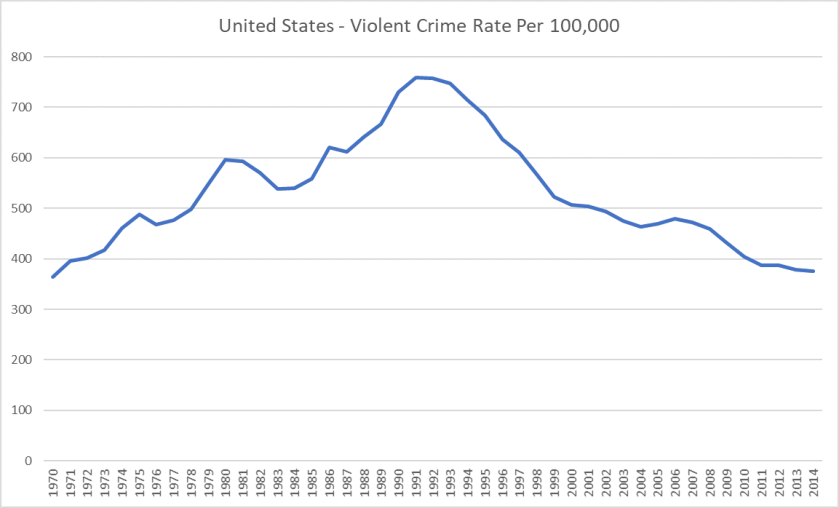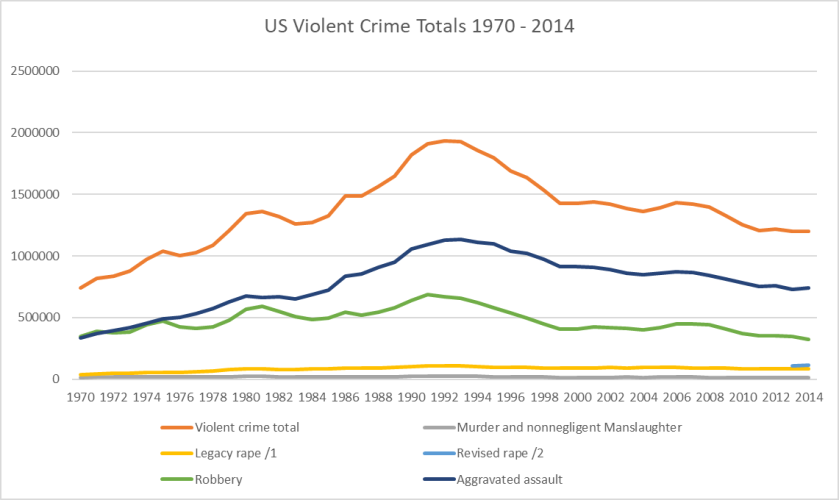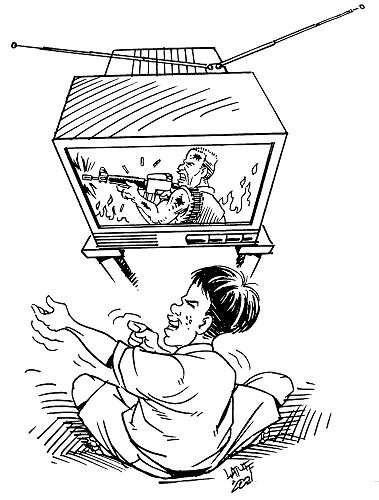Can a novel turn its readers into killers? Can a video game make a teenager commit murder? Nowadays, laypeople and scientists alike almost always answer this too-simple question with a resounding “nay.” The Catcher in the Rye didn’t make Mark David Chapman shoot John Lennon, and Wolfenstein 3D didn’t make the Columbine shooters commit the atrocity they did – but don’t dot that period quite yet. The issue of media’s effect on the individual has been a sore topic for ages, with examples ranging from loincloths being added to Michelangelo’s nude works to movies being regulated with age ratings – point being, that this centuries-old issue is one that must be treated with nuance. A metaphorical semicolon, then, would be more appropriate instead; media still holds massive influence on the individual. Can fiction affect the realities of those who consume it? Absolutely – a resounding “yea” to that – but how, why, and in what ways? Different media will influence its consumers through different methods, but in the last twenty to thirty years, as its industry has grown, the realm of video games has received a lot of criticism in regards to perpetuation of harmful stereotypes and misinformation.
What our team has proposed is a non-profit website whose purpose is to provide factual, scholarly evidence to combat the misinformation that popular video games can unintentionally perpetuate. Each article on the website will be aimed at a particular video game – new or old – and will first deconstruct which parts of the game we feel may be harmfully misleading. Second, the article will present the reality of the elements that its target video game has misrepresented, and provide suggestions to writers, artists, and other current or potential industry employees on how to avoid these harmful social pitfalls.

A mock-up of our proposed website
It might seem silly at first, but the goal of our website is not to nitpick plotholes, cliches, or argue against the realism of game mechanics – it is to amend the distorted social realities that many games unintentionally cultivate in their consumers.
Distortion of social reality through media, fictional or fantastical as that media may be, is common enough to have its own name: the cultivation effect, which Campbell (2014) defines as “[suggesting] that heavy viewing of television leads individuals to perceive the world in ways that are consistent with television portrayals” (p.533). This effect is, of course, not just limited to television. Frequent playing of video games can and does lead gamers to unconsciously absorb the social info their games provide. Trouble is, that social info is often incorrect, with storytelling crutches that are normalized and prevalent within a game’s world – “storytelling crutches,” in this instance, meaning writing elements born from audience pandering or ill-informed writing, like stereotyped or absent minorities, over-representation of men, or portrayal of foreign countries as radically different.
Now consider a less extreme example, of a study done in 2015 concerning exactly what it sounds like: Portrayal of radiology in a major medical television series: How does it influence the perception of radiology among patients and radiology professionals? The study by Heye (2015) found that “the perception of radiology is accurately portrayed for patients and technologists, but not for radiologists” (p.1). “Radiologists should be aware,” Heye continues, “of this cultivation effect to understand their patients’ behaviour which may create false expectations towards radiological examinations and potential safety hazards” (p.1) Perhaps subverting expectations, video games are not distinct from shows like the ones mentioned, even with unrealistic mechanics like infinite lives or instant healing. Teng (2017) lays out the reason why in his study on violent video game exposure:
First, violent video games trigger automatic social perceptions, creating real sensations. Accordingly, a qualitative analysis suggested that the role played in a violent video game is also consistent with a virtual society where morality exists (Hartmann et al., 2014). Second, although violent video games involve a virtual environment, users’ default mode of perception appears to be to perceive things as real, which is likely to be the result of automatic processes, and exciting violent cues or motivational effort are required to restrain awareness in an ‘‘apparent reality’’ (p.55)

The cultivation effect and gender roles, Blackstone, Amy (2003)
With this in mind, the cultivation effect, unsurprisingly, can be observed in all kinds of mediums, interactive or not, fictional or not, and across all genres – and though much of the research concerning the cultivation effects’ link to video games focuses on violence, our website aims at more overarching issues. A study by Hopp (2017) neatly explains the need for focus on greater issues – he says that “about 20 percent of all video games sold in United States are first-person shooter (FPS) games” which he believes is an issue because most of these games take the same approach to “[employing] an identifiable metamessage, or an overall logical depiction of how social relations ought to be conducted” (pp. 1-2). The message of these games, Hopp argues, is that “serious – sometimes existential – geopolitical issues are most effectively solved using armed confrontation,” and that as a result, these games unintentionally brew militarism in gamers (p.2).

Call of Duty Black Ops II, an FPS which received criticism for its portrayal of middle-eastern countries, via callofduty.com
So how do we fix it? One of the main goals behind our website is to give our readers another perspective on cultural reality, but that’s just treating the symptom. The greater goal of ours is to get those same readers to demand more of the companies and individuals who develop their favorite games, to enter the game industry themselves, and to change the shape of the industry as a whole. However,the pandering nature of many AAA games has created a self-fulfilling barrier to entry for many women and minorities, making our goal a hard task to accomplish. As Harvey (2015) says, “despite the range of statistics showing nearly equal play across males and females, and an increasingly wide range of games, platforms, and controllers available on the market, on the production side, the constitution of the labour force remains strikingly homogeneous” (p.578) It seems, though, that things are starting to look better in recent years.

The disproportionate gender ratio of game developers, via forbes
Looking for a fresh perspective, we contacted Randall Mosey, a former EA employee and current 1099 contractor. “I think we’ve made a lot of progress in addressing social issues,” Randall says, when asked how today’s game developers are responding to demands to address social issues. “But I feel,” he continued, “ that we still have a long way to go. The pressure to meet these demands should feel natural like any other requirement.”

EA, one of the biggest game companies in the world, via @inside_EA
Randall doesn’t believe his opinions make him an outlier in the industry either – he thinks the tides are beginning to turn, but not as smoothly as he’d hope. We asked him if misrepresentation of foreign countries and minorities was still an issue throughout the American and global game industry, and he responded with the following:
The concern with whitewashing and the lack of deep understanding has definitely lead to some serious misrepresentation in the past and I feel that we could be doing a much better job bringing diversity into the gaming communities. European and Japanese markets are no exception to this and I feel we should be working together as a global industry to bring us together.
Randall is hopeful for a future where the industry has dealt with the massive problem of unfair representation, since “the misrepresentation or general disregard for the culture and conduct of nations other than our own can lead to misinformation being understood as fact. Video games have a large impact on the mindset.”
It’s clear that the homogeneous nature of the American game industry has created a number of issues – those that self-perpetuate throughout the industry, those that cultivate misinformed social realities in the general public, and those that create a barrier to entry for minorities looking to enter the industry. But if the public can become more aware of the existence and consequences of the cultivation effect – and they can and have become more aware over time – we can slowly burn away at the inequality and misinformation cultivated within and by the industry.
References
Campbell, R., Martin, C. R., & Fabos, B. (2014). Media & culture: Mass Communication in a Digital Age (9th ed.). Boston: Bedford/St. Martinʼs.
Harvey, A., & Fisher, S. (2015). “Everyone Can Make Games!”: The post-feminist context of women in digital game production. Feminist Media Studies, 15(4), 576-592.
Heye, T., Merkle, E., Leyendecker, J., Boll, D., Gupta, R., Merkle, E. M., & … Gupta, R. T. (2016). Portrayal of radiology in a major medical television series: How does it influence the perception of radiology among patients and radiology professionals?. European Radiology, 26(8), 2863-2869. doi:10.1007/s00330-015-4079-3
Hopp, T. (2017). Use of military-themed first-person shooter games and militarism: An investigation of two potential facilitating mechanisms. Computers in Human Behavior., 78, 192-199.
Teng, Z., Nie, Q., Guo, C., & Liu, Y. (2017). Violent video game exposure and moral disengagement in early adolescence: The moderating effect of moral identity. Computers In Human Behavior, 7754-62.
















